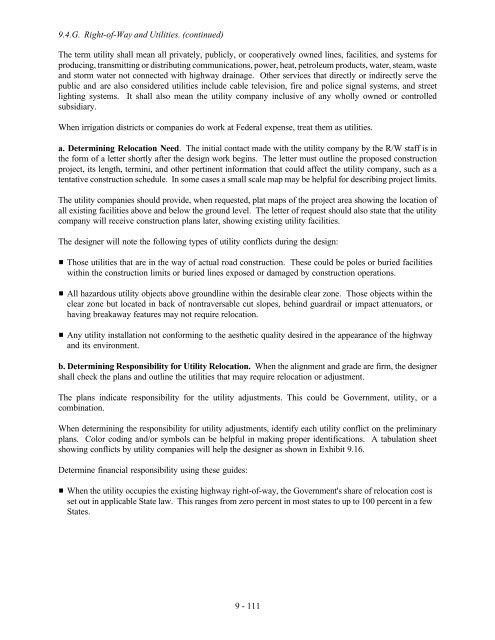FLH PDDM Chapter 9 - Eastern Federal Lands Highway Division
FLH PDDM Chapter 9 - Eastern Federal Lands Highway Division
FLH PDDM Chapter 9 - Eastern Federal Lands Highway Division
You also want an ePaper? Increase the reach of your titles
YUMPU automatically turns print PDFs into web optimized ePapers that Google loves.
9.4.G. Right-of-Way and Utilities. (continued)The term utility shall mean all privately, publicly, or cooperatively owned lines, facilities, and systems forproducing, transmitting or distributing communications, power, heat, petroleum products, water, steam, wasteand storm water not connected with highway drainage. Other services that directly or indirectly serve thepublic and are also considered utilities include cable television, fire and police signal systems, and streetlighting systems. It shall also mean the utility company inclusive of any wholly owned or controlledsubsidiary.When irrigation districts or companies do work at <strong>Federal</strong> expense, treat them as utilities.a. Determining Relocation Need. The initial contact made with the utility company by the R/W staff is inthe form of a letter shortly after the design work begins. The letter must outline the proposed constructionproject, its length, termini, and other pertinent information that could affect the utility company, such as atentative construction schedule. In some cases a small scale map may be helpful for describing project limits.The utility companies should provide, when requested, plat maps of the project area showing the location ofall existing facilities above and below the ground level. The letter of request should also state that the utilitycompany will receive construction plans later, showing existing utility facilities.The designer will note the following types of utility conflicts during the design:Those utilities that are in the way of actual road construction. These could be poles or buried facilitieswithin the construction limits or buried lines exposed or damaged by construction operations.All hazardous utility objects above groundline within the desirable clear zone. Those objects within theclear zone but located in back of nontraversable cut slopes, behind guardrail or impact attenuators, orhaving breakaway features may not require relocation.Any utility installation not conforming to the aesthetic quality desired in the appearance of the highwayand its environment.b. Determining Responsibility for Utility Relocation. When the alignment and grade are firm, the designershall check the plans and outline the utilities that may require relocation or adjustment.The plans indicate responsibility for the utility adjustments. This could be Government, utility, or acombination.When determining the responsibility for utility adjustments, identify each utility conflict on the preliminaryplans. Color coding and/or symbols can be helpful in making proper identifications. A tabulation sheetshowing conflicts by utility companies will help the designer as shown in Exhibit 9.16.Determine financial responsibility using these guides:When the utility occupies the existing highway right-of-way, the Government's share of relocation cost isset out in applicable State law. This ranges from zero percent in most states to up to 100 percent in a fewStates.9 - 111
















